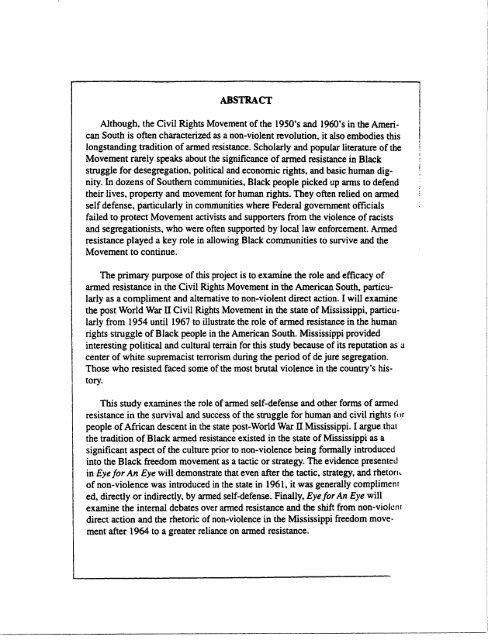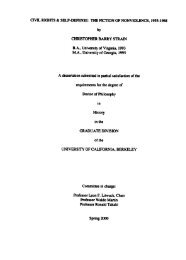Eye for an Eye: The Role of Armed Resistance ... - Freedom Archives
Eye for an Eye: The Role of Armed Resistance ... - Freedom Archives
Eye for an Eye: The Role of Armed Resistance ... - Freedom Archives
Create successful ePaper yourself
Turn your PDF publications into a flip-book with our unique Google optimized e-Paper software.
ABSTRACT<br />
Although, the Civil Rights Movement <strong>of</strong> the 1950's <strong>an</strong>d 1960's in the Americ<strong>an</strong><br />
South is <strong>of</strong>ten characterized as a non-violent revolution, it also embodies this<br />
longst<strong>an</strong>ding tradition <strong>of</strong> armed resist<strong>an</strong>ce . Scholarly <strong>an</strong>d popular literature <strong>of</strong> the<br />
Movement rarely speaks about the signific<strong>an</strong>ce <strong>of</strong> armed resist<strong>an</strong>ce in Black<br />
struggle <strong>for</strong> desegregation, political <strong>an</strong>d economic rights, <strong>an</strong>d basic hum<strong>an</strong> dignity.<br />
In dozens <strong>of</strong> Southern communities, Black people picked up arms to defend<br />
their lives, property <strong>an</strong>d movement <strong>for</strong> hum<strong>an</strong> rights. <strong>The</strong>y <strong>of</strong>ten relied on armed<br />
self defense, particularly in communities where Federal government <strong>of</strong>ficials<br />
failed to protect Movement activists <strong>an</strong>d supporters from the violence <strong>of</strong> racists<br />
<strong>an</strong>d segregationists, who were <strong>of</strong>ten supported by local law en<strong>for</strong>cement . <strong>Armed</strong><br />
resist<strong>an</strong>ce played a key role in allowing Black communities to survive <strong>an</strong>d the<br />
Movement to continue .<br />
<strong>The</strong> primary purpose <strong>of</strong> this project is to examine the role <strong>an</strong>d efficacy <strong>of</strong><br />
armed resist<strong>an</strong>ce in the Civil Rights Movement in the Americ<strong>an</strong> South, particularly<br />
as a compliment <strong>an</strong>d alternative to non-violent direct action . I will examine<br />
the post World War II Civil Rights Movement in the state <strong>of</strong> Mississippi, particularly<br />
from 1954 until 1967 to illustrate the role <strong>of</strong> armed resist<strong>an</strong>ce in the hum<strong>an</strong><br />
rights struggle <strong>of</strong> Black people in the Americ<strong>an</strong> South . Mississippi provided<br />
interesting political <strong>an</strong>d cultural terrain <strong>for</strong> this study because <strong>of</strong> its reputation as a<br />
center <strong>of</strong> white supremacist terrorism during the period <strong>of</strong> de jute segregation .<br />
Those who resisted faced some <strong>of</strong> the most brutal violence in the country's history.<br />
This study examines the role <strong>of</strong> armed self-defense <strong>an</strong>d other <strong>for</strong>ms <strong>of</strong> armed<br />
resist<strong>an</strong>ce in the survival <strong>an</strong>d success <strong>of</strong> the struggle <strong>for</strong> hum<strong>an</strong> <strong>an</strong>d civil rights fm<br />
people <strong>of</strong> Afric<strong>an</strong> descent in the state post-World War II Mississippi . I argue that<br />
the tradition <strong>of</strong> Black armed resist<strong>an</strong>ce existed in the state <strong>of</strong> Mississippi as a<br />
signific<strong>an</strong>t aspect <strong>of</strong> the culture prior to non-violence being <strong>for</strong>mally introduced<br />
into the Black freedom movement as a tactic or strategy. <strong>The</strong> evidence presented<br />
in <strong>Eye</strong> <strong>for</strong>An <strong>Eye</strong> will demonstrate that even after the tactic, strategy, <strong>an</strong>d rhetort .<br />
<strong>of</strong> non-violence was introduced in the state in 1961, it was generally compliment<br />
ed, directly or indirectly, by armed self-defense . Finally, <strong>Eye</strong><strong>for</strong>An <strong>Eye</strong> will<br />
examine the internal debates over armed resist<strong>an</strong>ce <strong>an</strong>d the shift from non-violent<br />
direct action <strong>an</strong>d the rhetoric <strong>of</strong> non-violence in the Mississippi freedom movement<br />
after 1964 to a greater reli<strong>an</strong>ce on armed resist<strong>an</strong>ce .

















